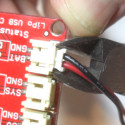Matthijs Kooijman
Member Since: May 9, 2014
Country: Netherlands
-
AFAIU LiPo batteries are also sensitive to being punctured or dropped, which can cause internal short-circuits and ultimately fire. It would be good if this tutorial also discussed these issues? And perhaps some info on figuring out charge rates from datasheets (e.g. what 1C charging means) would be useful too?
-
Check the schematic - regulator is MIC5219, which specifies a voltage input up to 12V. The I/O pins are shifted using a transistor.
Question for SparkFun: Why does the description say that the voltage input must be <= 5V? Looking at the schematic, it should handle voltages up to 12V just fine (of course, the I/O pins will then also output 12V, so this doesn't work when connecting to a standard Arduino). Or is there some kind of thermal limitation with the regulator?
-
And one more suggestion for a future revision: Instead of connecting to pin 2 and 3, connect to pin 8 and 9. This makes it easier to use the shield with AltSoftSerial, which is a lot more reliable than SoftwareSerial (and the latter doesn't care about the pins used). Also, this frees up pin 2 and 3, which are interrupt pins, so commonly used on other shields (like ethernet or wifi).
-
One more suggestion for a future version: The newest S2C XBee modules support being used as an SPI slave instead of using a UART. Given the lack of a free UART on most Arduinos, it would be good if there was a shield that supported this, possibly using switches or (solder) jumpers.
-
I tried some fiddling with jumper wires (pin 0 to 3, 1 to 2) to allow my computer to talk to the XBee module, through the USB-to-serial adapter on my Uno. This does not seem to work and I presume this is because the voltage converter on this board uses 1k pullups, while the Arduino Uno also has 1k resistors in series on the TX and RX lines (between the USB-to-serial adapter and the pin header, not between the pin header and the 328p). Together, those form a 50/50 voltage divider, breaking transmission.
Any chance that a future revision of this board could use bigger pullups to enable this trick to work?
-
In powerdown sleep mode, the clock isn't running, so timer0 isn't running either. Only pin change interrupts, external level interrupts, TWI address match and watchdog timer interrupt can wake the MCU IIRC.
-
I'm slightly confused about the specs for these batteries. As already mentioned the 2C discharge rate is not mentioned in the datasheet (the datasheet does mention 0.2C as a "typical" discharge rate in tests, but I couldn't find any mention of a maximum discharge rate at all). Also, for the charge rate, the datasheet says that "fast charge" can happen at 1C, but then the remarks say "250mA". AFAIU, 1C would mean 400mA (or perhaps 450mA, as the datasheet mentions 400mAh as the minimum capacity and 450mAh as the typical capacity).
So, any additional information about this?
-
The description says there is a SPDT switch, but AFAICS that should be DPDT (there's two lines that are being switched, DIN and DOUT, so that's two poles).
No public wish lists :(




